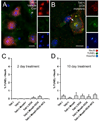Morphine causes rapid increases in glial activation and neuronal injury in the striatum of inducible HIV-1 Tat transgenic mice
- PMID: 18551626
- PMCID: PMC2725184
- DOI: 10.1002/glia.20708
Morphine causes rapid increases in glial activation and neuronal injury in the striatum of inducible HIV-1 Tat transgenic mice
Abstract
HIV encephalitis (HIVE) is accompanied by brain inflammation, leukocyte infiltration, and glial activation, and HIV patients who abuse opiates are more likely to develop HIVE. To better understand how opiates could alter HIV-related brain inflammation, the expression of astrocyte (GFAP immunoreactivity) and macrophage/microglial (F4/80 or Mac1 immunoreactivity) markers in the striatum, and the percentage of 3-nitrotyrosine (3-NT) positive macrophages/microglia, was determined following a 2-day exposure to morphine (5 mg/kg/day via time-release, subcutaneous implant) and doxycycline in GFAP-driven, doxycycline-inducible HIV-1 Tat transgenic mice. Data show that both morphine and Tat induction via doxycycline increased astrocyte activation, with significant additive increases achieved with combined morphine and doxycycline exposure. By contrast, combined Tat induction and morphine exposure, but neither manipulation alone, significantly increased the proportion of macrophages/microglia present in the striatum of transgenic mice, although morphine exposure was necessary to elevate 3-NT co-detection in Mac1-positive macrophages/microglia. Finally, Tat induction increased the percentage of neurons expressing active caspase-3, and this was even more significantly elevated by co-administration of morphine. In spite of elevations in caspase-3, neuronal TUNEL reactivity was unchanged in all groups, even after 10 days of Tat induction. Importantly, co-administration of naltrexone completely antagonized the effects of morphine. These findings indicate that morphine rapidly and significantly increases the activation of astrocytes and macrophages/microglia in the brains of inducible Tat transgenic mice, supporting the theory that early inflammatory changes in glia could underlie the development of HIVE in opiate-abusing AIDS patients.
Figures






References
-
- Aldovini A, Debouck C, Feinberg MB, Rosenberg M, Arya SK, Wong-Staal F. Synthesis of the complete trans-activation gene product of human T-lymphotropic virus type III in Escherichia coli: demonstration of immunogenicity in vivo and expression in vitro. Proc Natl Acad Sci U S A. 1986;83:6672–6676. - PMC - PubMed
-
- Anderson CE, Tomlinson GS, Pauly B, Brannan FW, Chiswick A, Brack-Werner R, Simmonds P, Bell JE. Relationship of Nef-positive and GFAP-reactive astrocytes to drug use in early and late HIV infection. Neuropathol Appl Neurobiol. 2003;29:378–388. - PubMed
-
- Anthony IC, Ramage SN, Carnie FW, Simmonds P, Bell JE. Does drug abuse alter microglial phenotype and cell turnover in the context of advancing HIV infection? Neuropathol Appl Neurobiol. 2005;31:325–338. - PubMed
-
- Avgeropoulos N, Kelley B, Middaugh L, Arrigo S, Persidsky Y, Gendelman HE, Tyor WR. SCID mice with HIV encephalitis develop behavioral abnormalities. J Acquir Immune Defic Syndr Hum Retrovirol. 1998;18:13–20. - PubMed
-
- Avison M, Berger JR, McArthur JC, Nath A. HIV meningitis and dementia. In: Nath A, Berger JR, editors. Clinical Neurovirology. New York: Marcel Dekker, Inc.; 2003. pp. 251–276.
Publication types
MeSH terms
Substances
Grants and funding
LinkOut - more resources
Full Text Sources
Molecular Biology Databases
Research Materials
Miscellaneous

